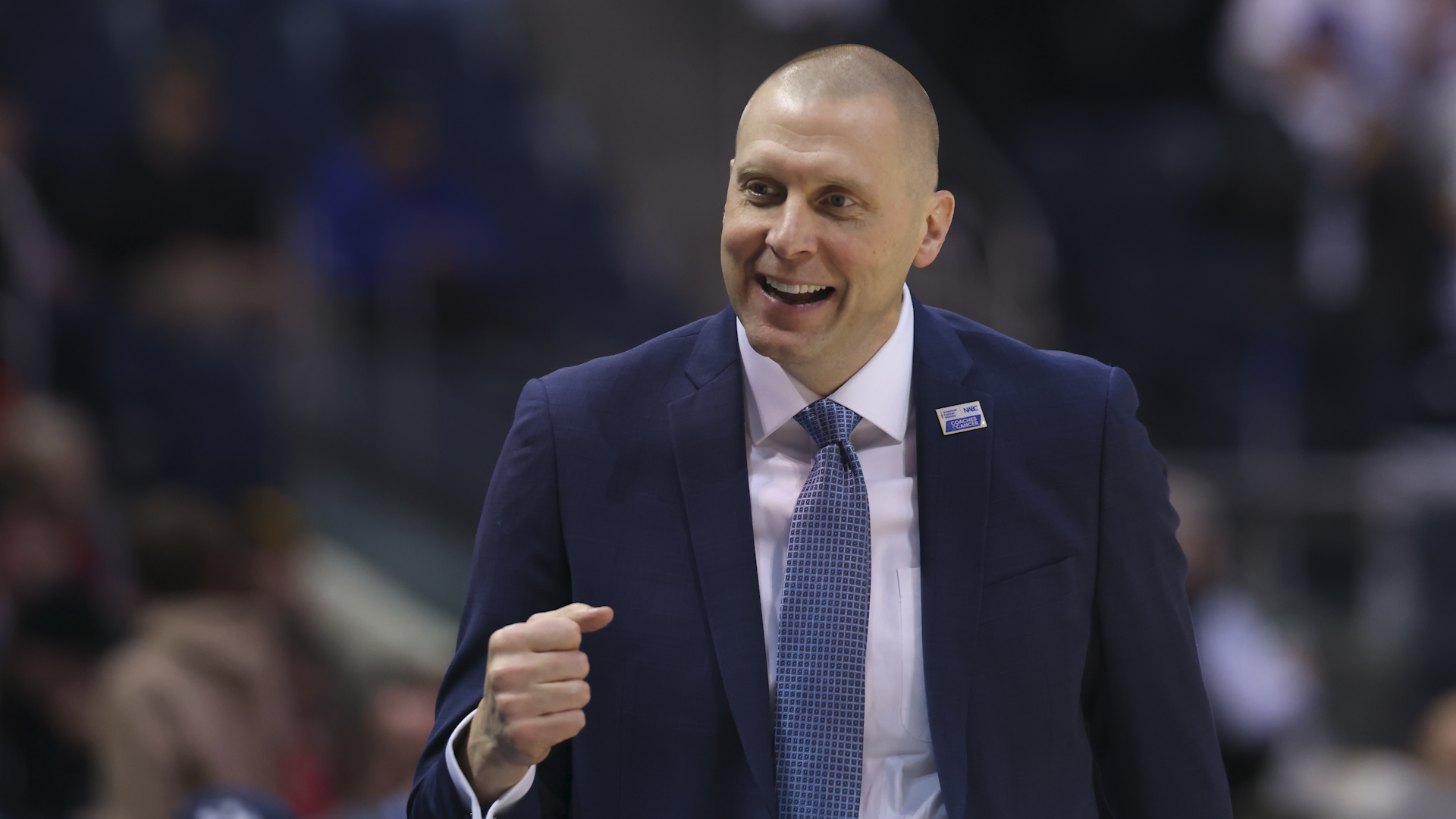Big man platoons are all the rage in college basketball’s arms race: Know these eight combos in 2024-25 season
Written by Lucky Wilson | KJMM.COM on August 6, 2024

Honesty is the best policy for Matt Painter. The Purdue coach preaches it on the recruiting trail and practices it with his rotations. Nearly three years ago, he asked Trevion Williams, a reigning first-team, All-Big Ten selection, to embrace a bench role so that Purdue could start a blooming sophomore named Zach Edey.
Before he became a two-time National Player of the Year, Edey formed half of one of the best center platoons in recent memory.
Painter expressed pessimism that Edey, a 7-foot-4, 300-pound big man, could play alongside Williams, a 6-foot-10, 255-pound dancing bear, so he halved the 40 minutes almost perfectly. Edey and Williams played together for just four minutes and one second that 2021-22 season. It was a little awkward at times, but it worked. Purdue leaned on the second-best offense in the country to win 29 games, and its centers combined to average 26.4 points and 15.1 rebounds per game which, conveniently, sounds ridiculously similar to Edey’s video game-like stat lines from the last two years.
That center platoon made Purdue look a little different than most of its counterparts.
Three years later, that center platoon has erupted.
The explosion of player movement, fueled by the NIL market and an utterly absurd 67-man coaching carousel, has forced more staffs to build a roster from scratch. Roster-construction in 2024 has become sort of like building a house, and putting a center platoon in the blueprints has become a massive priority. Over half (40 of the 77) of the teams housed in the five richest, high-major conferences have some semblance of a center platoon in place.
Maybe it’s a bit like Moneyball. Finding a guy to replace Zach Edey’s 25 points and 12 rebounds in the portal wasn’t feasible, but, with how much Purdue feeds its bigs, Painter might be able to get 20 points and 10 rebounds from a combination of Trey Kaufman-Renn and 7-foot-3 freshman center Daniel Jacobsen, who impressed mightily for Team USA’s U18 club this summer.
It also allows some coaches to play a few different ways on both ends of the floor. UConn’s defense used a bunch of drop coverage when elite shot-blocker Donovan Clingan was in the game to limit shots at the rim. But when backup Samson Johnson checked in, he aggressively blitzed ball screens. UConn allowed more shots at the rim with Johnson on the floor, but it forced many more turnovers. BYU’s offense became a tough scout because it went five-out with Aly Khalifa at the 5 and four-out, one-in when Fousseyni Traore checked in. Keep your head on a swivel.
That tactical flexibility is a cheat code and something many have tried to emulate. For example, new DePaul coach Chris Holtmann paired a 3-point shooting big man with some defensive questions in David Skogman with a non-shooting big man with outstanding defensive chops in NJ Benson. Butler’s 1-2 punch of Andre Screen and Boden Kapke has that same vibe.
There are also real physical advantages to it. Centers are, ahem, large dudes. Asking for 20-to-25 minutes of high-motor play is substantially easier, and it gives added moldability when foul trouble pops up. Centers can play harder and maybe take more calculated risks because they know they aren’t expected to be on the floor non-stop.
Let’s dive into some of the noteworthy center platoons that were constructed this offseason:
Kentucky Wildcats
The personnel: Amari Williams and Brandon Garrison
The scoop: Mark Pope’s sharp offensive system requires big men who can pass the rock. That’s a huge piece of Williams’ game. The fifth-year senior out of Drexel gives Pope a smart dribble handoff hub who can whip backdoor dimes or spray it out to Kentucky’s cavalry of 3-point shooters. Garrison can also do a bunch of those things, too. Williams is the vet. Garrison is the young, rising sophomore. Together, Kentucky should be able to have 40 minutes of a real playmaking big man on the floor who also has plenty of defensive chops. Williams’ durability is a real question. He only played 30+ minutes twice last season, so Garrison is clearly poised to play early and often. Don’t be surprised if this is close to a 50-50 split.
UConn Huskies
The personnel: Tarris Reed and Samson Johnson
The scoop: Dan Hurley might have a big say in the boom of big men brigades. UConn’s back-to-back National Championship-winning clubs had two of the best backup centers in the sport in Clingan in 2022-23 and Johnson this past season. The development of Michigan transfer Tarris Reed will have a big say on whether UConn downshifts to a true 50-50 platoon. As of now, Johnson is slated to become the unquestioned starter. The rim-running, high-flying center finally gets a chance to be the man in the middle, but if Johnson still can’t defend without fouling, Reed will hear his number called. Reed has to improve his decision-making, but the burly junior has all the makings of UConn’s next version of Adama Sanogo who eats rebounds for breakfast, lunch and dinner.
NC State Wolfpack
The personnel: Brandon Huntley-Hatfield and Ben Middlebrooks
The scoop: Middlebrooks was an unsung hero in NC State’s rise from the dead to a Final Four appearance. He provided a monster second-unit big man who covered way more ground defensively than the more offense-leaning DJ Burns.
Kevin Keatts should recreate that intimidating big man tandem with Huntley-Hatfield and Middlebrooks in 2024-25. Huntley-Hatfield, a Louisville transfer, is more offense-leaning as a true post-up threat with developing pick-and-pop skills. He’s probably the best bet to start with Middlebrooks doing so much of the same things he did last year as a high-energy, rugged defender. Middlebrooks’ motor would be the same with 15 minutes a night or 25 minutes. That’s a luxury. NC State should lean on that center platoon early and often.
Arizona Wildcats
The personnel: Motiejus Krivas and Tobe Awaka
The scoop: Tommy Lloyd got an eye-popping 18 points and 14 rebounds per game from his centers last year. It’s a safe bet to project Krivas and Awaka to match or exceed that benchmark. They look so different but they’re both extremely effective. Krivas is a 7-foot-2, 265-pound crane. Awaka is a 6-foot-8, 250-pound fire hydrant. Both were excellent post-up scorers last year with outstanding rebounding rates. Arizona may have one of the best center platoons in the country because both Krivas and Awaka would start for a ton of high-major teams.
Tennessee Volunteers
The personnel: Felix Okpara and JP Estrella
The scoop: Things are changing in Tennessee’s frontcourt with Jonas Aidoo charting to Arkansas and Tobe Awaka off to Arizona. Ohio State transfer Felix Okpara and JP Estrella look poised to split the 40 minutes at the 5. Okpara is a phenomenal lob threat who uses his length and hops to be a real menace on both ends of the floor. But Okpara struggled to be an efficient post-up scorer throughout his first two years at Ohio State. That’s where Estrella comes into play. The blooming sophomore might be Tennessee’s best post-up scorer on the roster, and he showed plenty of toughness and physicality battling Zach Edey in the NCAA Tournament. This is Okpara’s job to lose, but Estrella has the tools to make this a full-blown platoon.
BYU Cougars
The personnel: Fousseyni Traore and Keba Keita
The scoop: Traore and Keita are both non-shooting big men, but other than that, they’re completely different. That’s a good thing for new BYU coach Kevin Young. He’ll have options for who mans his 5-spot. Traore is a polished low-post scorer who can finish with both hands. The 6-foot-6, 240-pound senior is mostly a below-the-rim finisher, but the bowling-ball big man carves out space, draws fouls and is a career 74% free throw shooter. Keita is a way more explosive athlete. Keita has absurd bounce and opponents shot just 52% at the rim against Utah last year when Keita was on the floor. But he’s a poor free throw shooter and, while effective, can be a bit clunky on the block. Traore gives BYU a reliable, post-up threat. Keita provides that vertical pop BYU’s frontcourt desperately needed on its backline. They should split time.
Illinois Fighting Illini
The personnel: Morez Johnson and Tomislav Ivisic
The scoop: Jockeying for playing time has already gotten started in the Illini frontcourt, and its two freshmen seem destined to compete for the starting center role. Johnson, a coveted top-31 prospect in the Class of 2024, is a hellacious rebounder who runs the floor like a deer. The 6-foot-9, 225-pound big man is a tad undersized and isn’t a proven floor-spacer yet, but that motor is always revving. Ivisic is a bit different. The Croatian big man isn’t a typical freshman. He’ll turn 21 on Aug. 9, and he owns a 7-foot-1, 230-pound frame. He’s not as explosive athletically as Johnson, but Ivisic is a knockdown free throw shooter who can also stretch the floor and operate as a five-out hub. Ivisic’s age and skill give him a slight nod, but Johnson’s a workhorse who projects to be an outstanding offensive rebounder from the jump. Offensive rebounding is a massive piece of Brad Underwood basketball. The success of Illinois’ big man platoon is shaping up to be a massive X-Factor for its Big Ten Championship hopes.
St. John’s Red Storm
The personnel: Zuby Ejiofor and Vince Iwuchukwu
The scoop: Rick Pitino’s two heavyweight guards (Deivon Smith and Kadary Richmond) are shaping up to the be stars of this team, but Ejiofor and Iwuchukwu will get the first crack at replacing All-Big East big man Joel Soriano. The double-double machine was used to being a frontline star. Ejiofor and Iwuchukwu aren’t elite post-up scorers (yet), but St. John’s needs play-finishers and elite rim protection. Ejofor and Iwuchukwu have all the physical tools to impact winning at a high level. St. John’s doesn’t have an All-Big East center on the roster right now, but its platoon will be productive and important.
The post Big man platoons are all the rage in college basketball’s arms race: Know these eight combos in 2024-25 season first appeared on OKC Sports Radio.

 KVSP
KVSP 












